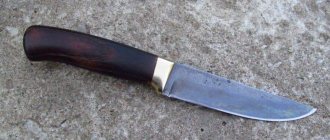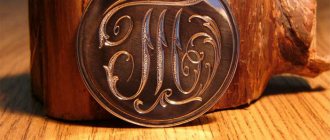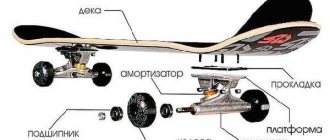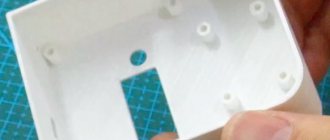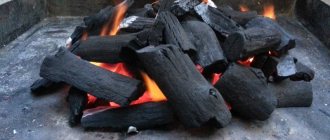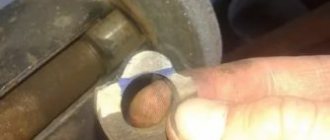: Security measures
The most important thing is safety. The manufacturing process involves forging, grinding and immersing the metal in chemicals, so it is important to use the proper equipment to ensure safety.
For the forge welding phase (forge welding), many people who do any forging work know the basic safety gear: gloves, apron, closed boots, etc. However, the conditions are not always met. Everyone knows eye protection is important, but for this type of work you need a special kind of protection. The above and only photo in this section is of neodymium glasses. The reason for this is that such glasses are simply necessary for such work.
Experts often neglect this protection, but do not repeat after them. The heat required for forge welding creates radiation that can cause vision loss over the long term. Neodymium glass, however, blocks most of the radiation and keeps your eyes safe. Please note: Neodymium glasses are not the same as welding helmets or sunglasses. By using them in forge welding, your pupils will dilate and your eyes will receive even more radiation.
The process of making a knife in a workshop
We have already visited the forge and seen how damascus strips are made, now let's see what happens to them next.
First of all, you need to use a special pattern to trace the outline of the future blade on the workpiece, cut it off from a strip of metal forged in a forge and cut it along the contour.
In the photo (from left to right): marking the workpiece, the workpiece and the pattern, cutting along the contour.
Forging metal using a mechanical hammer allows for slight differences in the thickness of the metal in the forged plate; therefore, it is necessary to align the blade along the plane. After this, the blade is given geometry according to the pattern and drawing, and it is also at this stage that, for example, cutting is done using biconcave lens technology.
In the photo (from left to right): a cut blank, alignment on a plane, giving geometry to the blade.
After the steps described above, we get a blade that is already quite close in appearance to what we are used to seeing on store shelves, but rather rough-looking and without a pattern. The blade must be polished to a mirror finish. Next, the workshop mark is applied (the area for applying the mark is preheated) and holes are made for the rivets if all-metal installation is provided.
In the photo (from left to right): grinding, stamping, drilling holes for rivets.
Not a single blade will have the declared properties if it is not hardened. We move on to the next stage of thermal hardening. The blade is hardened in a thermal furnace at a certain temperature and receives a blade hardness of 62 HRC on the Rockwell scale. After this, the surface is cleaned from scale using a sanding belt and the blade would have become a finished product, if not for one small thing - there is no design. The pattern that makes Damascus - Damascus, manifests itself when the blade is exposed to nitric acid; all the manipulations in the forge with various steels, welding and twisting them, were needed precisely for this moment, to reveal the pattern.
In the photo (from left to right): thermal hardening, descaling, etching of the design.
Actually, the blade is almost ready; all that remains is to sharpen the sharpening angle; let’s pay a little attention to the handle. We install the handle in two versions with a shank and all-metal installation. With the all-metal version, I think no questions should arise; holes for the rivets are drilled and the pads are attached to them. All-metal construction is the most reliable type of fastening, but most people prefer the more traditional fastening with a shank. For a material such as birch bark, celmet installation is almost impossible.
In the photo (from left to right): firing of the shank, the handle disassembled, the handle before turning.
For installation, the shank is annealed, the metal is tempered for drilling holes, a pin is attached to the rivet - the guard and handle can be attached. And the last stage is shaping the handle - the knife is ready. All that remains is to give it the required sharpening angle to the cutting edge, depending on its purpose.
I am attaching a number of photographs that were not included in the main description; unfortunately, the originals were large in size, so all the photographs in the article had to be compressed for normal loading on mobile devices and tablets, so I had to abandon enlargement by clicking.
When the blank is ready, it's time to forge the blade
We pull off the body, the nose of the future blade and the shank. You can also forge descents, but in this case the metal pattern will be poorly revealed.
Fig. 20. (blade after forging).
Fig. 21. (blade after forging).
We polish the future blade and trim the ends
Figure 22 (blank).
Then we put a mark, weld the shank and mark future descents
Fig. 23. (blank).
Figure 24. (blank).
After that, on the grinder, we roughly form the descents.
Fig. 25. (blade before hardening).
It's heat treatment time
We do normalization in order to remove stress from forging and refine the grain of the metal. Next is quenching: heat it in a quenching forge to the quenching temperature and lower it into a container with oil heated to seventy degrees. After which we conduct a vacation - heating to a temperature of two hundred degrees and holding for two hours.
Figure 26. (quenching forge).
Fig. 27. (hardening the knife).
Fig. 28. (blade after hardening).
Now we grind the knife clean and etch it in a five percent solution of ferric chloride - this is necessary to reveal the design. As a result, we get such a blade
Fig. 29. (finished blade) - which my friend dubbed “Element”.
How to sharpen a Damascus steel knife
To sharpen a Damascus knife with your own hands, you need to consider the following nuances:
- part of the blade with nicks and chips needs to be cut down for alignment;
- sharpening the knife is done slowly and carefully so that one layer of the layered structure does not bend onto another - for this, abrasive materials with successively decreasing grain size are used;
- sharpening is carried out diagonally - sharpening the blade lengthwise is ineffective;
- sharpening grooves and stripes spoil the design of the product - they need to be polished with a fine-grained material;
- The sharpened knife must be wiped with a napkin; you can use lemon zest.
Sharpening a knife made of pre-Mas steel.
Blanks for the production of Damascus
Any craftsman can make Damascus steel at home; alloy kits are used for this. They contain soft and hard inclusions. By combining them with each other, they achieve blades with pronounced structural patterns.
The following combinations are used, shown in the table. Some workshops offer their own options. The proposed schemes give the best performance.
When starting production in your own workshop, it’s easy to find out how much the finished product costs. Many online shopping sites list prices. As you gain experience and improve the quality of the product, you can increase the price of your products.
Video: how to make Damascus steel?
What is real damascus and damask steel
Previously, the technology for making such weapons was kept secret - only craftsmen knew how to make Damascus steel, and the products themselves were highly valued and incredibly expensive. However, even now knives made from these materials are an expensive pleasure, so a considerable percentage of models belong to the category of collectible weapons.
Damascus
The technology for producing Damascus steel involves forging twisted carbon steel rods/plates. Due to forging, the layers are flattened and become very thin - the multilayer structure provides the blade with the necessary strength characteristics.
Bulat
Unlike Damascus, damask blades are made by casting. According to the technology for preparing damask steel, high- and low-carbon steels are used - as a result of melting, the melt with a low carbon content contains partially molten particles of the high-carbon component.
The difference between damask steel and damask
The advantages of damask steel and Damascus steel have divided lovers of such weapons into two camps. So when choosing, buyers rely more on personal preferences. As mentioned above, even by external signs (by drawing), clearly identifying these materials is not a problem.
Damask steel.
: Forge welding
After placing the product in the oven, heat it until it turns bright orange or yellow. Once it reaches the appropriate temperature, let it sit for another minute or so to allow all the metal to absorb the heat and heat evenly.
The cable must be twisted before the shots can be made. It is filled with empty space, which is bad for forge welding. Secure one end of the cable in a vice or similar and use whatever handy tool you find suitable (I used pliers) to twist the sections in the direction the cable is already twisted.
This step may require several reheats. Continue twisting the cable until it stops curling. Make sure the cable does not bend as this will make the whole process much more difficult.
Each time, before putting the cable into the fire, you need to sprinkle it with borax until the metal becomes homogeneous. To ensure that the borax sticks to the metal, pour it in at a time when the product is bright red. An important point: when borax melts, it becomes corrosive and can damage the inside of your forge, so make sure the bricks in your forge are fireproof.
Additionally, hot borax on your skin can be quite painful and may leave scars, so be sure to wear appropriate gear. The last part of forge welding is the weld itself. When the item is hot, you can start hitting it. The idea is to first knock it out into a square block shape. When you hit, you have to watch the cable turn. Personally, I prefer to start in the middle and work my way to the ends.
Impacts will cause the fibers to separate from each other, so it is necessary to reduce the distance from the first impact to the next as much as possible. You will understand that the product has become homogeneous by the changed sound that will be produced when struck. Initially, it will be duller, but as soon as the metal becomes homogeneous, the sound will become bright and ringing. Once it becomes homogeneous, you can begin to shape it into the desired shape.
How to make Damascus steel at home?
Translated by SaorY for mozgochiny.ru
Greetings to all brain crafters ! After almost a year of “communication” with a hammer and an anvil, I finally acquired the necessary experience and tools to create forged crafts , such as the small “Damascus” knife from this brain article .
And I started, by the way, with a small sledgehammer as an anvil, which I hit with a small hammer.
Now we will talk about creating a small, forged, not carved, knife with your own hands using a homemade forge, anvil, hammer and determination. I don’t pretend to be a professional, and this is certainly not the only way to obtain welded Damascus; this is the story of how I managed to make it.
Damascus steel today is called welded Damascus, obtained from welded metal plates of various brainsteels , subsequently forged and twisted. It's like molding different colors of plasticine together and twisting it to create a wavy pattern.
After forging, such a workpiece is subjected to etching, in which the dissimilar metals of the workpiece are eroded unevenly, thereby creating a beautiful contrast.
The original Damascus steel is obtained in a different, very specific way (although it looks similar to modern Damascus), and few people know how to create it; this fact has given Damascus a reputation as a metal supposedly endowed with magical powers.
And the reason for this “power”, similar to samurai swords, is a process that makes it possible to obtain a more homogeneous, and therefore with the desired qualities, steel, which cannot be achieved in other ways, and makes it possible to include low-quality and high/low carbon steel in the workpiece. Which results in a much better quality blade.
!!! ATTENTION!! A knife can be dangerous, please do not give it to people with mental disorders!!!
Step 1: Materials and Tools
- steel plates of two or more grades (preferably high carbon content) that will contrast with each other, I took high carbon 1095 steel and 15n20 steel, with a small nickel content, which will add brightness and contrast after etching - flux (borax, which can be purchase at a hardware store) - a piece of reinforcement, a long rod (will be welded to the workpiece as a handle) - wood of your choice for the knife handle - epoxy resin (hardening in 5 minutes is the best) - brass rivets - composition for processing the wood of the handle, I I used linseed oil - metal hardening oil (vegetable)
- ferric chloride
- an anvil (preferably a real steel anvil, although if you don’t have one, some other durable objects will do: a piece of rail, a sledgehammer, a large metal blank, an old bollard mooring post, or just a large strong, hard and flat surface.
Remember how it all started with hitting a large stone with a stone - a hammer (I used a weight of 1.
3 kg, with a cross striker) - pliers - welding (optional, but desirable for welding the plates to each other and welding the handle, if you do not have welding, you can tightly wrap the plates with wire) - forge (capable of heating the workpiece to the temperatures required for forging , which is very important for high-quality fusion of the plates with each other, more on this later) - a belt sander or file with a lot of patience - an oven or another hardening method - a drill or drilling machine
- vice (very useful thing)
Step 2: Assembling the workpiece
Steel plates are cut to the required brain dimensions , mine, for example, are 7.6x1.2cm; Moreover, the larger the workpiece, the more difficult it is to shape it with a hammer.
Before welding them in a stack, the plates are cleaned from all sides of rust and scale.
Next, the plates are stacked, alternating steel grades, so my workpiece consisted of 7 plates, three of which were grade 15n20, and four of which were grade 1095.
The plates, aligned relative to each other, are welded together (don't pay too much attention to my seam), and then a handle is welded to the stack to make it easier to handle the workpiece during forging. There is nothing wrong, especially after the stack of plates have been welded, in using only pliers. I forged my own anyway.
Step 3: First Forging of the Stack
A little about my forge: I made it with my own hands from an empty (I bought a new one on purpose as a precaution) gas cylinder, lined inside with a 5cm layer of kaolin wool and fireproof cement. It is heated by a Ron-Reil type burner, about which there are many good brainstorming articles . The forge itself is not particularly large and can be heated to the required temperature without any problems.
So, the workpiece from the plates is heated to a cherry-red color; the heat for this does not need to be very strong.
The heated
homemade is sprinkled with borax, which immediately begins to melt and must be allowed to seep between the plates.
This will remove scale and prevent oxidation by preventing oxygen from contacting the metal. This action will ensure the purity of the workpiece metal.
Then the workpiece is heated again in the forge and the procedure is repeated a couple more times, not forgetting to clean the scale if necessary.
And after this, the workpiece is heated to forging temperature, I can’t say exactly how much, but I believe it’s somewhere in the region of 1260-1315 degrees Celsius.
At this temperature, the workpiece will have a very bright yellow-orange color, similar to moderate daylight.
To avoid wasting time, make sure that the anvil and hammer are at hand and there is enough free working space.
Then the workpiece is quickly placed on the anvil and with light, soft blows, evenly over the entire area, the forging of the plates begins. Next, the workpiece is again placed in the forge and heated to forging temperature, and then forged with blows of medium force.
And after this, the workpiece is stretched so that it can be bent.
Step 4: Folding the workpiece
It's time to increase the number of brain layers in the workpiece. To do this, the workpiece is forged to a length twice the original length, but it is important to stretch it evenly and not just stretch it.
In the middle of the stretched workpiece, a transverse recess of 3/4 or 4/5 thickness is made using a notch, chisel or other suitable method, along which the workpiece is then folded in half on the edge of the anvil, turned over and forged along the entire length, making sure that the halves do not moved relative to each other along the lateral edges.
Then the heating/forging process from the previous step is repeated: flux, heat, cool, heat, forge, forge.
The procedure for increasing the number of layers is repeated until the required number of these layers, so I folded it 4 times and got 112 layers. (If you want more layers, please, the pattern will then be smaller.
The formula for calculating layers is: initial quantity * 2 to the power of the number of folds, that is, 7 * 24 = 112).
homemade workpiece, heated to forging temperature, is placed in the groove of the anvil, twisted thoroughly, and then it is again given a rectangular shape.
But before twisting, the workpiece is punched in the corners so that its shape becomes more rounded, because when twisting and reverse forging into a rectangular workpiece, inclusions and impurities can form from the resulting folds if the temperature of the workpiece is lower than the forging temperature.
After this, the brain blank is forged again (I repeated it several times), and cooled, and to make sure that the forging is uniform, I cleaned one of the ends of the blank.
During the forging itself, especially at the first stage, it is important to keep the temperature of the workpiece high and be careful, otherwise you can tear the layers away from each other (this is also called delamination, which is not at all good).
Step 5: Model and Rough Profiling
Now you need to imagine the profile of the future knife and roughly forge it from the blank. The more accurately you can forge the profile and bevel, the less you will have to bother with grinding (on a machine or with a file).
There are many brain articles from more experienced blacksmiths, so I will not go into detail.
The bottom line is that the workpiece behaves approximately like plasticine; when it is heated, it is necessary to punch it in the desired direction.
Step 6: Sanding the Profile
The final shaping of the profile is carried out with a grinder and a file. Stock up on tea, because most likely this will take a lot of time, unless of course you have a brain grinding machine .
Step 8: Finished profile
After the profile of the craft is formed, it still needs to be finalized with a file with a finer grain, I used 400s.
The edge of the blade is sharpened almost, but not completely; it is necessary to leave it slightly unsharpened so that during hardening the edge material does not deform.
After this, holes for rivets are drilled in the knife handle and wooden dies for this handle are prepared.
Step 9: Exciting Moment
Hardening. It will either “make” your blade or destroy it. It is important to concentrate and be careful, otherwise you can deform and destroy the blade. The method I used is not the most thorough brain-hardening , but it was the only one available to me with the tools I had, and the oil was the best I could get.
Before hardening, the blade must be normalized. This will relieve stresses built up during forging and twisting and reduce the likelihood of warping during hardening. This normalization is done by heating the blade above its critical temperature (when it is no longer magnetized, so it is useful to have a magnet on hand) and cooling it in air.
Step-by-step technology for making damask steel from bearings
Products from finished ingots or billets are produced in the following sequence.
The inner ring of the bearing is made of ShKh-15 alloy. It is sawed with a grinder cutting disc and sent to the forge for heating. The desired heating temperature is 900…950 ⁰С.
The workpiece is held on the anvil with blacksmith tongs. By beating off the bulges with a hammer, a strip is formed from the ring.
Remove depressions from the strip.
The grinder gives the desired shape.
The workpiece is held in place using a special mandrel. A constant angle allows you to create identical slopes on both sides.
The final shape of the product is obtained by turning.
GOI paste and an auxiliary velvet roller help polish the surface.
After polishing, a finished blade is obtained. All that remains is to make the handle, bolster and sheath. Then the product can be considered finished.
Equipping a workshop for the production of products
In the workshop of a home craftsman who wants to start making products from Damascus steel, you need to have:
- Welding machine - with its help, plates of materials of different strengths are welded into a single block, which can be processed together.
- Forge - it heats blanks from finished items to high temperatures (more than 800 ⁰C).
- An anvil is needed for forging. Forge welding is performed using the deformation method; the shape of the part changes at different stages of processing.
- A set of hammers and mallets helps you strike with different strengths. When working together, the leading blacksmith uses a light hammer to show the assistant where to strike with a heavy hammer.
- A vice is used to hold workpieces at different stages of work.
- A drill press is needed to drill holes.
- The sharpening machine is used more often than others; it gives shape and sharpness to products.
- A grinder is a variant of a sharpening machine; its distinctive feature is the use of an abrasive-coated tape glued into a ring. Using a grinder, smooth slopes are formed at a given angle.
- Machine for making slopes. High-quality sharpening to razor sharpness is possible only with a special device that allows you to move along a strictly defined trajectory.
- Grinder with a set of cutting and cleaning discs. A simple tool provides assistance in performing a variety of types of actions.
Types of patterns
As a result of the technological process for creating Damascus steel, a unique pattern is formed on the surface - a pattern. There are several types.
Wild Damascus
The most common and easiest to manufacture. It got its name due to its disordered pattern. A package of strips from several grades of steel is welded into a single block. They bend it repeatedly and forge it again. The layers of metal mix randomly. The pattern is formed randomly and looks heterogeneous.
One of the most ancient varieties of Damascus steel. It is highly popular among collectors due to the unique design of each product: knife, saber, dagger.
Stamped
A variation of traditional damask. The pattern is more uniform. Geometric shapes alternate: circles, stripes, rings. Includes two manufacturing methods:
- The metal package is welded in advance. The stamp strikes are applied in a given order. The finished product is polished. Excess metal is removed from the surface in order to more clearly demonstrate the relief and pattern.
- The pattern is applied to the bag using a metalworking method - with a milling cutter or drill. Then the package is forged.
Stamps (stamps are a German word, from which the name is derived) are divided according to the type of drawing:
- reticulate;
- stepped (staircase);
- wavy;
- rhombic;
- ringed
The patterns are similar to wood veneer or circles on water.
The types of patterns are in turn divided into a wide variety of patterns. A master blacksmith can stand out with his specific signature style. In the USA, damask with a peacock eye pattern, products with a pattern in the form of crosses, imitation of barbed wire or mesh are popular. To manufacture the first, uniform drilling of metal is used across the entire width of the workpiece.
Turkish Damascus steel
Refers to the traditional type of patterned steel. The manufacturing method involves forging a bundle of intertwined steel rods. The composition of the rods varies. A complex pattern is formed on the surface - many smooth wavy lines. The size of the lines depends on the chemical composition of the metal of the rods, their diameter, and the method of twisting.
Japanese
It stands out for its fine layered steel structure. The surface is etched. The structure of the alloy appears thanks to unusual polishing. Hardening also has its own characteristics. The handle of the blade is covered with a protective layer of clay mixture. Only the blade itself is hardened. The result is reflected in the properties of the Japanese sword. The blade becomes hard, sharp and brittle. The handle remains elastic.
Mosaic
A modern version of Damascus. It got its name because of the specific manufacturing method. The layered structure gives a beautiful decorative effect. There are two most popular manufacturing methods:
Shell
A metal pipe or container is used to connect mosaic elements. Contrasting steel is placed inside. The container is filled with inert gas or oil. When heated, oxygen binds. A neutral environment is formed inside the shell. The pipe is completely welded. In this state, the shell is sent to the forge. Heats up to welding temperature. Forging often occurs using a hydraulic press. After the formation of a single mass of metal, the shell is removed. A mechanical method is used for removal. The resulting workpiece undergoes further processing.
Technological
Holes are cut in the steel bar in accordance with the specified pattern. Metal inserts of a different chemical composition of equal diameter are placed in the holes. Holes and liners are cut with a plasma cutter. The package is welded using the diffusion method.
The advantage of this method is the ability to create the necessary drawings and various images. Unlike surface engraving, the pattern covers the entire thickness of the blade.
Fibrous
This method is used to make high-quality Japanese knives. The layers of steel are not positioned to the length of the future blade. The rods are finely chopped and laid out at right angles. In this form, the package is forged.
Combined
Combines classical and traditional manufacturing methods. Both methods are applied simultaneously, hence the name. A stamp pattern is applied to the block assembled using the mosaic method. The surface is forged and polished. In the case of applying relief by drilling or milling, the prepared alloy is forged and etched. Grinding is not used in this case.
It is also possible to combine the technique of forging wild Damascus and inserting a metal alloy with contrasting properties. Nickel is used as an alloy that differs in composition. It has a white color, which allows it to stand out against the background of the overall black and gray pattern of the blade.
Industrial
Produced on industrial equipment of metallurgical enterprises. The quality of the blades does not differ from the handmade work of blacksmiths. The scale of production is much larger. The type of patterns can differ into wild, mosaic, combined.
Making a sword. From ore to critsa
For a very long time, the technologies for producing and processing iron remained practically in one place; they could not properly satisfy the ever-growing demand for this metal, so there were few iron products and they were expensive. And the quality of tools and weapons made from this metal was extremely low. Surprisingly, for almost three thousand years metallurgy has not undergone any fundamental changes.
Before moving on to a description of the process of making edged weapons in ancient times, several definitions related to metallurgy should be given.
Steel is an alloy of iron with other chemical elements, primarily carbon. It determines the basic properties of steel: a large amount of carbon in steel ensures its high hardness and strength, while reducing the ductility of the metal.
The main method of producing iron in Antiquity and the Middle Ages (until the 13th century) was the cheese-blowing process, so named because unheated (“raw”) air was blown into the furnace. The main method of processing the resulting iron and steel was forging. The cheese-blowing process was very inefficient; most of the iron from the ore was lost along with the slag. In addition, the resulting raw materials were not of high quality and were very heterogeneous.
The production of iron from ore took place in a cheese furnace (a cheese furnace or domnitsa), which had a shape resembling a truncated cone, 1 to 2 meters high and a base diameter of 60-80 cm. Such a furnace was made of refractory brick or stone, coated with clay on top, which was then burned. A pipe led into the furnace to supply air; it was pumped in using bellows, and in the lower part of the house there was a hole for removing slag. A large amount of ore, coal and fluxes were loaded into the furnace.
Later, water mills were used to supply air to the furnace. In the 13th century, more advanced stoves appeared - stukofen, and then blauofen (15th century). Their productivity was much higher. A real breakthrough in metallurgy took place only at the beginning of the 16th century, when the conversion process was discovered, during which high-quality steel was obtained from ore.
The fuel for the cheese-making process was charcoal. Coal was not used due to the large amount of impurities it contains that are harmful to iron. They learned to coke coal only in the 18th century.
In a cheese furnace, several processes occur at once: waste rock is separated from the ore and leaves in the form of slag, and iron oxides are reduced, reacting with carbon monoxide and carbon. It fuses and forms the so-called kritsa. It contains cast iron. After receiving the kritsa, it is broken into small pieces and sorted by hardness, and then each fraction is worked on separately.
Today cast iron is the most important product of ferrous metallurgy; in the past it was different. It cannot be forged, therefore in ancient times cast iron was considered a useless waste product (“pig iron”), unsuitable for further use. It significantly reduced the amount of raw materials obtained during smelting. They tried to use cast iron: in Europe they made cannonballs from it, and in India, coffins, but the quality of these products left much to be desired.
Flaws
The main disadvantage is the low resistance to metal corrosion due to the high carbon content in the composition. Finished products require careful care and storage.
The absence of alloying elements - the necessary components to impart certain physical properties to the metal - leads to the formation of rust on the surface of the blade. As a result, the blade can quickly become unusable.
It is recommended to store Damascus steel products in an oil composition.
High cost of products. Intricate manufacturing, unique patterns, and the metal's superior strength characteristics contribute to the high price tag.
Use of high-quality steel in products
It's not just weapons that need durable materials. Structural materials with special properties are used in a wide variety of industries.
Forged products work in cars, railways, agricultural machinery, and spaceships. Only very simplified technology is used. Forging is used to achieve fine grain in the structure of the metal. Possible cavities that are present in the castings are eliminated.
An example of a modern blade with a pronounced pattern:
There are pros and cons for Damascus steel.
Positive characteristics
- High strength of the product, withstands loads applied in different directions (compressive, tensile, bending and other types of loads).
- Wear resistance of the cutting edge, holds its edge for a long time.
- It has an unusual appearance, it is impossible to repeat the design on a similar object, it makes it recognizable.
- High cost of implementation.
A special type of Damascus steel made from wire rope:
The listed advantages often attract craftsmen to engage in production using the technology of repeated forging of workpieces. For each new batch of goods, its own forging methods and sequence can be used.
Flaws
The main disadvantage is the high labor costs for producing the product. It is necessary to resort to repeated heating of the workpiece.
High carbon steel is susceptible to corrosion. To the question: “Does it rust?” We can answer unequivocally that without proper care, rust quickly destroys the product.
Damascus steel fin, modern product:
Calculation of average carbon content in Damascus steel
There are a lot of articles written about Damascus steel, but since you're about to make it, it's worth repeating some of the theoretical points. Damascus steel consists of alternating layers of high and low carbon steel.
The average carbon content of Damascus
plays an important role .
It can be calculated as follows:
Suppose you welded a package of 30 grams of St3 and 70 grams of U8. So your Damascus is 30% steel with 0.3% carbon and 70% steel with 0.8% carbon. Using a simple proportion, we calculate that (0.3 x 0.003 + 0.7 x 0.008) x 100 = 0.65. Therefore, the average carbon content in the bag is 0.65%. Not enough. It is also necessary to take into account that when the package is first heated to welding temperature, about 0.3% of the carbon burns out, and with each subsequent heating, about another 0.03%. This means that it is necessary to use higher-carbon steel grades, or to increase the relative content of U8 in the package. Using this formula, you can calculate the average amount of carbon in the package and, accordingly, select the appropriate hardening mode. An operation called carburization can increase the carbon content. It should also be remembered that a contrasting pattern is obtained when using steels whose difference in carbon is equal to or greater than 0.4%. The finished product is etched in one of the above reagents. In this case, the product must already be hardened (hardening increases the contrast of the pattern) and polished. The entire defatted product is placed in the etching solution, and the operation is continued until the pattern is clearly and completely visible.
Suitable materials
The clear favorite here is damascus made from cables, the metal from which the cables are made makes it possible to obtain a good blade material, but due to the large pattern it does not provide an increase in cutting (Damascus) properties
Fig. 1. (damask made of cable with a large pattern)
Figure 2. (damask made of cable with a small pattern)
But there are also cables that will not allow you to obtain good cutting properties (due to the small amount of carbon), in which case a cutting edge made of blade metal or damascus is welded to the body of the blade, or a laminate is made - where the blade material is in the center, and the lining is made of decorative cable damascus.
Fig. 3. (end welding: cutting edge wx15, Damascus body made of cable).
It should also be noted that although the material does not have good cutting properties in implementation, both in the laminate and in the end version, the cable, due to its elasticity, allows the use of very hard but brittle metal on the cutting edge, the strength deficiencies of which are compensated elastic cable Such a blade will bend faster and break faster.
Recycled materials such as chains are also widely used; most often they use either chainsaw chains or motor chains of gasoline engines.
Fig. 4. (damascus from the motor chain).
Meshes are more rarely used; their properties are basically similar to the cables described above.
Fig. 5. (laminate: in the center wx15, damascus mesh lining, against which the blade is removed)
Figure 5.1. (laminate: in the center wx15, Damascus mesh lining, mesh texture left on the blade)
Fig. 6. (laminate: in the center wx15, Damascus lining using stainless mesh).
It should be noted that there are quite a few such materials suitable for making bladed damascus; in this article I want to introduce you to the process of making a blade from a coil of wire. The essence of this experiment is to obtain a new pattern on the finished blade.
Fig. 7. (roll of wire).
: Final and defense
Damascus steel should look like one solid piece of metal. To get the pattern, you need to etch the steel with acid. There are several options for using acids, but personally I use ferric chloride. If you want a very superficial etching, such as an image on a surface, you only need to dip the metal in acid for about 20 minutes.
I wanted a very deep etching that you could feel, so I immersed my piece for 7 hours. Once you have finished etching, you must clean the metal and neutralize the acid. One of the easiest ways to do this is to simply spray glass cleaner onto the engraved piece after it has been rinsed with water. Be sure to wear gloves and eye protection for all of this. If you want to add some color to the piece, like in the last two photos, just heat it up a little after etching until the desired color is achieved.
Once the etching is complete, the final step is to protect the metal. Steel is strong, but unfortunately, it tends to rust. If the piece you are using needs to be practical, like a knife, you can apply wax to its surface.
If the piece is more decorative, you can apply a clear coat. It all depends on preference. Personally, I decided to try nail polish. I usually use clear polyurethane, but this time I decided to try something new. Once the piece is varnished, all that's left is to enjoy the look.
Chemical composition of wire
Before making a knife, we try to find out the approximate chemical composition of the wire, this is necessary in order to find out whether it is possible to weld it with forge welding and the approximate amount of carbon - this is necessary to find out whether the finished blade will be hardened. We carry out this complex analysis quite simply - by checking for a spark.
Fig. 8. (checking for spark).
From the spark we see that the metal is not alloyed, which tells us that it can be welded using a forge and that the amount of carbon is 0.8-1%, which allows us to assume that the metal will take a decent hardening. There is also the possibility of carbon burning out during forge welding, but we can only check this after welding.
Formation of a package for forge welding
Since the wire has become soft enough, we can bend it into a shape convenient for us, after which we wrap one end of it with soft iron and weld it with electric arc welding. A strip of iron is necessary to be able to use electric welding, because the wire is very thin and it would simply burn out. Then we weld a handle made of reinforcement for ease of holding during forge welding and further forging.
Fig. 10. (blank).
Now we heat our workpiece to about eight hundred degrees. I use a gas forge, it has a number of advantages, such as a constant reducing atmosphere and everything is clearly visible in it what is happening.
Fig11. gas horn
Then sprinkle generously with borax. Borax is needed to dissolve scale and protect the metal from oxygen - this is important for high-quality forge (forge) welding. Then we carry out the welding itself.
Fig. 12. (sprinkling with borax).
We carry out welding on a block of wood, this is necessary to protect the workpiece from oxygen; the fire that appears from the contact of the workpiece and wood burns out oxygen and creates a reducing environment outside the forge. And also for less heat transfer to the workpiece - that is, the wire is very thin and cools quickly upon contact with the anvil.
After forge welding, we forge the workpiece to the required dimensions; in this case, we are going to torso (twist) the workpiece - so we forge it into a square with a side of twenty mm. We measure with a crank, which will be used to twist the workpiece.
Fig. 14. (unforging).
Fig. 15. (preparation for torsion).
Now that we have prepared the workpiece, it is important to figure out how the pattern will be opened; at this stage, the fibers are located along the workpiece and the final product will not be very impressive. You can twist it - but then you get the same metal pattern as a regular cable, so in this case we twist it in different directions in increments of about one and a half to two centimeters
Fig. 16. (torso).
Fig. 17. (torso).
After which we trim the workpiece to the required size, in this case the square size is approximately twenty millimeters.
Fig. 18. (workpiece after torsion).
Fig. 19. (workpiece after torsion).
Knife handle care
Caring for the handle of a knife is no less important than maintaining the blade. Popular wooden and leather handles must be protected from prolonged contact with moisture to avoid deformation, swelling and cracking. If the handle gets wet, it should be dried in a warm and shaded place. If you dry a knife in bright sun or near heating devices, sudden evaporation of moisture and temperature changes can cause cracks, warping, and deformation.
The handle should be serviced along with the blade after each use of the knife and during routine inspection. Special furniture care products and vegetable oils, such as olive, linseed, and clove oils, are suitable for lubricating wood.
Handles made of horn or polymers should be wiped regularly and protected from moisture and direct sunlight.
Care of the scabbard
Knife care should not be one-sided. After cleaning the blade and lubricating the handle, you need to take care of the sheath. The main thing to understand here is that the sheath is a means of transporting a knife, and not a place for storing it. Tannins in the leather negatively affect the steel of the blade, and a wet and dirty knife left in the sheath for a long time can cause swelling and loss of elasticity of the material.
The outer surfaces of the sheath must be regularly cleaned of contaminants and treated with automotive leather conditioner. It is important not to forget to remove lint, grains of sand and other small debris from inside the sheath that may scratch the blade.
Leather easily absorbs stubborn pollutants such as rust. Therefore, if oxide has formed on the knife, you should not allow it to get on the surface of the sheath. It is also important to promptly renew torn seam threads and replace failed rivets.
